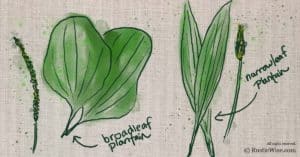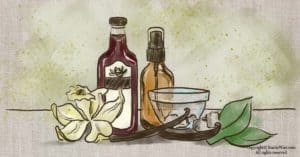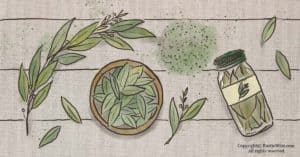Making the Cut: A Comparison of Wood vs Plastic vs Bamboo Cutting Boards
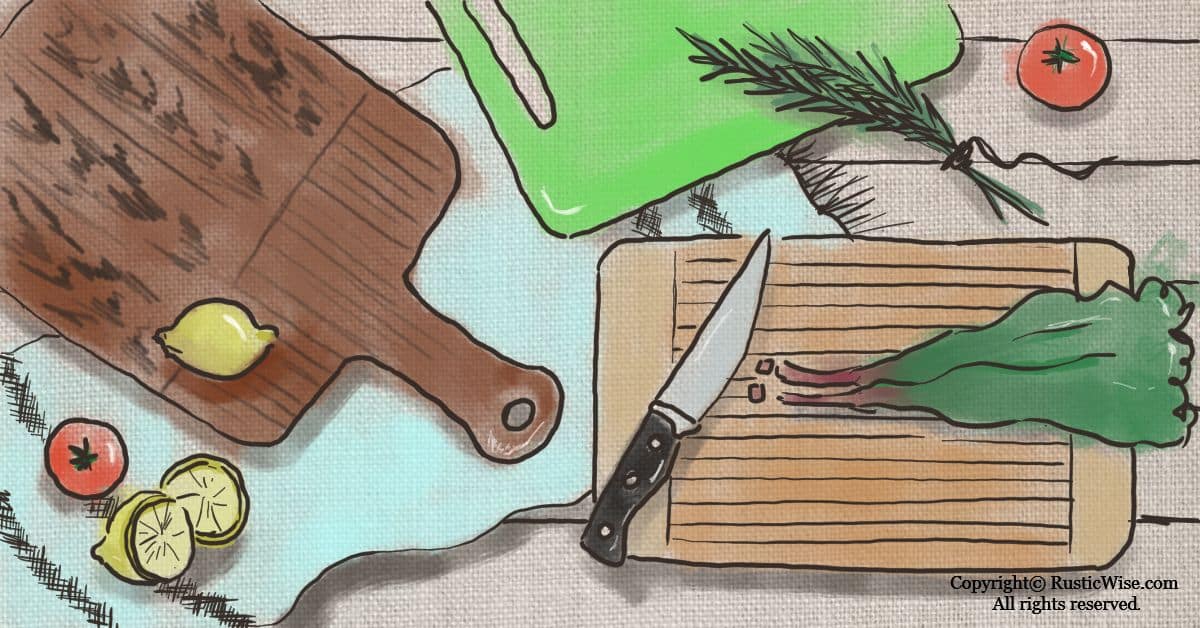
RusticWise is supported by its readers. When you purchase through links on our site, we may earn an affiliate commission. As an Amazon Associate, we earn from qualifying purchases. Thank You!
Not all cutting boards are created equal. While plastic cutting boards are inexpensive, they are certainly less attractive than their wooden counterparts. Bamboo boards are gaining steam, but how do they hold up with regular use?
We’ll answer these questions in our comparison of wood vs plastic vs bamboo cutting boards. In a nutshell, a wood cutting board absorbs juices and is long-lasting (but costs more). A plastic board is inexpensive but less durable and may harbor bacteria in the knife marks that develop over time. A bamboo board strikes a balance between being sanitary and at a more affordable price point than a wood board.
(Bonus: we’ll also cover glass and composite cutting boards too!)
Cutting boards are workhorses in the kitchen, an essential prep surface. You’ll want to ensure you select the best cutting board within your budget and needs.
Why it’s important to use the right type of cutting board
If you cook regularly, chances are, you’ll use some type of cutting board every day. Cutting boards come in contact with everything from raw vegetables to raw meat making them a potential source of food contamination and foodborne illnesses.
Food safety is one of the main concerns when it comes to cutting boards. While raw meat is often the culprit when it comes to risks of cross-contamination, even vegetables and fruits are sources of food-borne pathogens too.
Once upon a time, everyone used wooden cutting boards. Then the use of plastic cutting boards became more prevalent. Plastic, many people assumed, is supposedly more sanitary.
So, is it true that plastic cutting boards are more sanitary than wooden cutting boards?
Well, not really. While plastic cutting boards are easy to use and clean (most are dishwasher-friendly), they tend to harbor bacteria within grooves and cuts on the surface that develop overtime with use.¹
One study published in the Journal of Food Protection looked at the difference between wood and plastic cutting boards that were contaminated with different types of bacteria including Salmonella and Listeria. The results showed:²
“Bacteria inoculated onto Plastic blocks were readily recovered for minutes to hours and would multiply if held overnight. Recoveries from wooden blocks were generally less than those from plastic blocks, regardless of new or used status; differences increased with holding time.”
So wooden cutting boards tended to have less surface bacteria than plastic ones, regardless if they were new or used. However, wooden cutting boards absorbed the bacteria completely after 3-10 minutes.
Despite absorption, wooden cutting boards are still considered safe to use on meat. Wood cutting boards inhibit bacterial growth and any bacteria that’s absorbed into the cutting board eventually dies.
The importance of keeping your board clean
Perhaps more important than the type of material used is regular cleaning and maintenance. A filthy, scratched up wooden board that cost a small fortune is no better than a pristine, plastic cutting board that cost a few dollars.
While most plastic cutting boards are dishwasher safe and are easy to sanitize, a wood board requires a bit of TLC.
Check out our article on how to clean a wooden chopping board after cutting raw meat.
What makes a good cutting board?
When deciding upon the criteria of a so-called “good cutting board,” there are a few factors to consider. Some factors may be more important to you than others:
- Price: Plastic cutting boards can set you back a few dollars, while a high-end hardwood cutting board can cost up to several hundred dollars for an end grain butcher block.
- How you’ll use it: Are you planning on using it for cutting raw meat, or just some vegetables and cheese?
- Durability: Often durability and price go hand-in-hand—the steeper the price, the longer it’ll last. Of course how well you take care of it plays a vital role too.
- Easy on knives: Unless you love sharpening knives, you’ll want to consider a cutting board that won’t dull your blades.
- Size: A mid-sized cutting board is good for most purposes, but sometimes it’s handy to have a small one for slicing lemons, ginger, or other small foods.
- Maintenance: Do you want to throw everything into the dishwasher? Most plastic boards are easy to clean, while others like wooden boards require good, old-fashioned handwashing.
- Aesthetics: While beauty is in the eye of the beholder, I think most of us can agree that wooden cutting boards beat plastic in the looks department.
Which type of cutting board is most durable?
Quality, wooden cutting boards are the most durable, hands-down. They can last for years and maybe a lifetime if well maintained. Unlike plastic cutting boards, wooden cutting boards can be sanded down to remove any scratches, grooves, and knicks that develop over time. Use a food-grade mineral oil to treat your wooden boards and never soak it in water for long periods of time.
Depending on how often you use your plastic cutting board, they last one to two years on average before needing to be replaced. Bamboo durability falls somewhere in the middle.
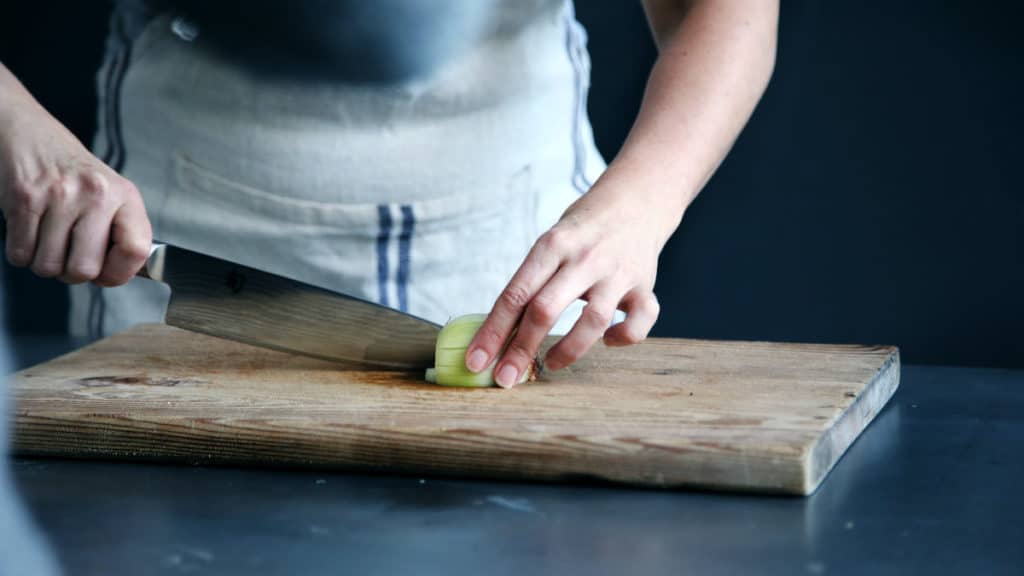
Which type of cutting board is best for knives?
A cutting board material with some “give” to it will keep kitchen knives sharp. Pick a softer material, such as wood, and in some instances, plastic to protect the knife’s edge from dulling.
Cutting boards with a hard surface are harder on knives. Glass cutting boards, for example, are very hard and quickly wear down a kitchen knife. While a glass cutting board is low maintenance, you’ll need to sharpen your knives regularly.³
Other hard materials such as marble are also rough on knives. A marble cutting board, while attractive, is best used for display rather than everyday kitchen prep work.
The most common type of material used for knives for home-use is stainless steel. Here’s a chart summarizing types of cutting boards and how they fare together with a stainless steel knife.
Chart: Cutting Board Material and Its Impact on Stainless Steel Knives
| Cutting Board | Knife Maintenance | Knife Chipping | Board Life |
| Softwood | Fair | Good | Fair |
| Hardwood | Fair | Good | Good |
| Plastic (HDPE) | Fair | Good | Good |
| Composite (phenolics) | Fair | Good | Good |
| Rigid (glass, marble) | Poor | Fair | Good |
Pros and cons of wood vs plastic vs bamboo cutting boards (plus glass and composite too!)
Wood cutting boards
The darlings of the cutting board world, wood boards are favored for their appealing looks and durability. A wooden cutting board can be made of either softwood or hardwood.
Hardwoods are preferable to softwoods as the grain is smaller and tighter, which leaves less room for bacteria to thrive in. Common hardwoods that are good choices for cutting boards include birch, cherry, oak, walnut, and hard maple.
Softwoods such as cypress and pine have a larger grain which tends to split and create ridges, grooves, and indents. These softwoods are not as durable for cutting boards.
A type of popular cutting board these days is acacia wood. Not only are these genuine wood, they are more affordable than traditional hardwoods, and also are attractive and water-resistant.
Pros of wooden cutting boards:
- Durable: Can last for many years or a lifetime with regular care. They can be sanded down to buff out scratches.
- Attractive: There’s a reason you often see them out on display on countertops—they’re easy on the eyes.
- Natural materials: Wood is a natural material and renewable resource.
- Easy on knives: Won’t dull the blades of your knives.
- Safe: High-quality wooden boards inhibit bacteria growth.
Cons of wooden cutting boards:
- Can be expensive: Quality hardwoods can cost anywhere from $100 for a slab to $300+ for quality end grain pieces.
- Requires regular maintenance: To maintain a natural buffer, wooden cutting boards need a regular coating of food-grade mineral oil.
- Can’t put in the dishwasher: Handwashing only, unfortunately.
- May absorb odors and bacteria: Over time, some wood cutting boards can develop a noticeable smell. This type of cutting board can absorb odors and bacteria if not properly cleaned after each use.
Plastic cutting boards
Most cutting boards are made of polyethylene, or high-density polyethylene plastic (HDPE). Plastic cutting boards are practical for everyday use, at home and in commercial kitchens. Others avoid plastic for environmental, or health reasons.
Some types of HDPE cutting boards are designed to be knife-friendly, meaning they don’t dull the blade of a knife. HDPE materials are FDA-approved for use in the kitchen and are food-safe. To protect both knife and board, avoid using serrated knives on plastic cutting boards.
Pros of plastic cutting boards:
- Inexpensive.
- Available in a variety of colors, shapes, and sizes.
- Easy to clean (dishwasher-friendly).
- Low maintenance (compared to wooden boards).
Cons of plastic cutting boards:
- Less durable.
- Becomes scuffed or scratched over time, making it easy for bacteria to find a home.
- Plastic material is generally not considered environmentally-friendly.
- Some low-quality plastic boards can dull the blades of your knives.
Bamboo cutting boards
While many people classify bamboo as a “wood” this is not entirely accurate. Bamboo is technically considered a type of fibrous grass. The USDA recommends bamboo cutting boards for their durability.⁴
So, are bamboo cutting boards sanitary? Yes, according to the USDA, bamboo is a safe and durable cutting board material.
“Bamboo absorbs very little moisture and resists scarring from knives, so they are more resistant to bacteria than other woods.”
—USDA
Applauded for its sustainability, bamboo is an eco-friendly material. While hardwoods can take decades to grow and harvest, bamboo grows in a fraction of the time.
Overall, a bamboo cutting board is a solid option and a popular cutting board type. It also strikes a balance between looks and price—less expensive than wooden boards but comparable in appeal.
The main downside is that it can dull knives over time due to its hardness.
Let’s take a look at bamboo cutting board pros and cons.
Pros of bamboo cutting boards:
- Eco-friendly and renewable.
- Less porous than wooden boards.
- Antibacterial properties.
- Comparable in looks to wooden boards.
- Less expensive than wooden boards.
Cons of bamboo cutting boards:
- Bamboo is a fairly hard material and can dull knives over time.
- Most require handwashing only (although there are some that are now dishwasher safe).
- Requires a bit of TLC with mineral oil like wooden boards.
Note: Some bamboo boards use formaldehyde-based glues which can release over time. Check the label before purchasing.
Glass cutting boards
We used to see a glass cutting board in kitchens a lot. Over time, they’ve become less popular. This might be partly due to the fact that glass cutting boards are hard on your knives (they easily dull the knife edge), and just unpleasant to work on (who wants to hear clank, clank, clank with every movement?). However, if you’re looking for a nonporous cutting board, glass is a good bet.
Pros of glass cutting boards:
- Easy to clean.
- Hard, non-porous surface.
Cons of glass cutting boards:
- Very hard surface easily dulls knife blades.
- Easy to chip or crack.
- Cold to work on.
What about composite cutting boards?
You may have heard of composite boards which are essentially a hybrid of wood and plastic. Made of wood fibers and phenolic resins, many of these boards claim to be knife-friendly; however, their hard surface says otherwise.
Pros of composite cutting boards:
- Durable.
- Available in a variety of colors, shapes, and sizes.
- Dishwasher safe.
Cons of composite cutting boards:
- Very hard surface and generally not considered knife-friendly.
- Thicker types can be pricey.
- Some thinner composite boards tend to flake over time.
So which type of cutting board should you use?
You’re probably wondering, what type of cutting board is best? If you’re still scratching your head over which type of cutting board is best, why not use a combination of boards? The USDA recommends using different cutting boards for different purposes to prevent cross-contamination.⁴
For most daily tasks such as cutting fruits, vegetables, cheeses, and breads, you can’t go wrong with wooden or bamboo boards.
For raw meats, there’s a raging debate about whether plastic or wooden cutting boards are better. Both work fine—just be sure to clean them thoroughly after each use and replace your old cutting board once it’s showing cut marks and grooves. Plastic doesn’t absorb liquids like wooden boards, and is easy to sanitize and clean.
On the flip side, you can safely cut meat on wooden boards, and they harbor less bacteria than plastic cutting boards, but properly cleaning it afterwards and properly maintaining it requires more effort.
And while we don’t recommend glass cutting boards for actually cutting on, they are handy to use when rolling out dough.
Related questions
Should you use a wood or plastic cutting board for meat?
According to the USDA’s Meat and Poultry Hotline (1-888-MPHotline), “…consumers may use wood or a nonporous surface for cutting raw meat and poultry. However, consider using one cutting board for fresh produce and bread and a separate one for raw meat, poultry, and seafood. This will prevent bacteria on a cutting board that is used for raw meat, poultry, or seafood from contaminating a food that requires no further cooking.”⁵
So, in other words, both wood or plastic is fine, so long as you prevent cross contamination and thoroughly clean and sanitize after cutting raw meat, poultry, or seafood.
Should you oil bamboo cutting boards?
Yes, it’s a good idea to oil bamboo cutting boards regularly to keep them in good condition. Use a food-grade mineral oil only (other vegetable oils may go rancid over time). Bamboo cutting boards are porous and can absorb moisture, which can cause them to warp or crack over time. Oiling the board helps to seal the surface, preventing moisture from being absorbed and prolonging the life of the board. Oil the board once a month or as needed.
What’s the difference between a charcuterie board and a cutting board?
The main difference is that a charcuterie board is meant to display a variety of meats and cheeses, while a wood cutting board can withstand chopping and dicing of foods. A charcuterie board is typically made of face grain wood which is not meant for food prep as the surface will quickly develop knife scratches. On the other hand, a wooden board is made either from edge grain or end grain wood which is more durable for everyday use.
You’re probably wondering, what type of cutting board is best? If you’re still scratching your head over which type of cutting board is best, why not use a combination of boards? The USDA recommends using different cutting boards for different purposes to prevent cross-contamination.⁴
For most daily tasks such as cutting fruits, vegetables, cheeses, and breads, you can’t go wrong with wooden or bamboo boards.
For raw meats, there’s a raging debate about whether plastic or wooden cutting boards are better. Both work fine—just be sure to clean them thoroughly after each use and replace your old cutting board once it’s showing cut marks and grooves. Plastic doesn’t absorb liquids like wooden boards, and is easy to sanitize and clean.
On the flip side, you can safely cut meat on wooden boards, and they harbor less bacteria than plastic cutting boards, but properly cleaning it afterwards and properly maintaining it requires more effort.
And while we don’t recommend glass cutting boards for actually cutting on, they are handy to use when rolling out dough.
Related questions
Should you use a wood or plastic cutting board for meat?
According to the USDA’s Meat and Poultry Hotline (1-888-MPHotline), “…consumers may use wood or a nonporous surface for cutting raw meat and poultry. However, consider using one cutting board for fresh produce and bread and a separate one for raw meat, poultry, and seafood. This will prevent bacteria on a cutting board that is used for raw meat, poultry, or seafood from contaminating a food that requires no further cooking.”⁵
So, in other words, both wood or plastic is fine, so long as you prevent cross contamination and thoroughly clean and sanitize after cutting raw meat, poultry, or seafood.
Should you oil bamboo cutting boards?
Yes, it’s a good idea to oil bamboo cutting boards regularly to keep them in good condition. Use a food-grade mineral oil only (other vegetable oils may go rancid over time). Bamboo cutting boards are porous and can absorb moisture, which can cause them to warp or crack over time. Oiling the board helps to seal the surface, preventing moisture from being absorbed and prolonging the life of the board. Oil the board once a month or as needed.
What’s the difference between a charcuterie board and a cutting board?
The main difference is that a charcuterie board is meant to display a variety of meats and cheeses, while a wood cutting board can withstand chopping and dicing of foods. A charcuterie board is typically made of face grain wood which is not meant for food prep as the surface will quickly develop knife scratches. On the other hand, a wooden board is made either from edge grain or end grain wood which is more durable for everyday use.
👉If you like this post, see our full Kitchen + Pantry section.
Would you like more timeless tips via email?
Fun tips to help you live an independent, self-sustaining lifestyle. Opt-out at any time.


References
- Shipman, Matt (23 September 2014). “Fast Facts About Cutting Boards and Food Safety in Your Kitchen,” NC State University. Accessed April 2023.
- Ak, N. O., Cliver, D. O., & Kaspar, C. W. (1994). Cutting Boards of Plastic and Wood Contaminated Experimentally with Bacteria. Journal of food protection, 57(1), 16–22. https://doi.org/10.4315/0362-028X-57.1.16
- Chen, Grant (10 May 2015). “Which Cutting Boards are Best for Knives?,” CuttingBoard.com. Accessed April 2023.
- U.S. Department of Agriculture (USDA), Cutting Boards and Food Safety, https://www.fsis.usda.gov/food-safety/safe-food-handling-and-preparation/food-safety-basics/cutting-boards. Accessed April 2023.
- U.S. Department of Agriculture (USDA), USDA Meat and Poultry Hotline, https://www.fsis.usda.gov/food-safety/safe-food-handling-and-preparation/usda-meat-and-poultry-hotline. Accessed April 2023.

Author: Josh Tesolin
Josh is co-founder of RusticWise. When he’s not tinkering in the garden, or fixing something around the house, you can find him working on a vast array of random side projects.


